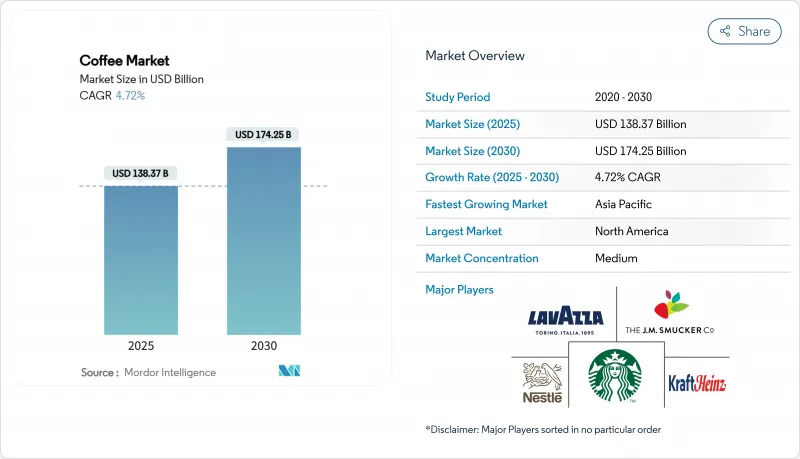
|
市場調査レポート
商品コード
1851927
コーヒー:市場シェア分析、産業動向、統計、成長予測(2025年~2030年)Coffee - Market Share Analysis, Industry Trends & Statistics, Growth Forecasts (2025 - 2030) |
||||||
カスタマイズ可能
適宜更新あり
|
|||||||
| コーヒー:市場シェア分析、産業動向、統計、成長予測(2025年~2030年) |
|
出版日: 2025年08月07日
発行: Mordor Intelligence
ページ情報: 英文 172 Pages
納期: 2~3営業日
|
概要
コーヒーの世界市場規模は2025年に1,383億7,000万米ドルと推定され、2030年には1,742億5,000万米ドルに成長すると予測され、予測期間中のCAGRは4.72%です。

この市場を牽引しているのは、プレミアムコーヒー、レディ・トゥ・ドリンク・オプション、より厳格な持続可能性規制に対する需要の高まりです。垂直統合されたコーヒー焙煎業者は、サプライチェーンの安全性を確保するためにトレーサビリティに注力しており、一方、専門ブランドは、ユニークなフレーバーに対する消費者の関心から利益を得ています。北米が最大の市場シェアを持つが、アジア太平洋が最も急成長しており、これは都市部の若い消費者が紅茶よりもコーヒーを選ぶようになってきているためです。アラビカ種はその風味から依然として最も人気の高いコーヒーであるが、天候が変化する中で生産を維持するためには、気候に強い作物の開発が不可欠となっています。製品タイプ別では、プレミアム・グラウンドが市場をリードする一方、インスタントコーヒーが急成長しています。原産地別では、混合原産地が優勢だが、単一原産地が牽引役となっています。市場の競合は緩やかで、JM Smucker、Nestle、Luigi Lavazza S.p.A.といった大手企業が目立っています。テクノロジーを駆使したサプライチェーンの透明化や消費者への直接販売といった戦略が、差別化の鍵になりつつあります。
世界のコーヒー市場の動向と洞察
特殊でプレミアムなコーヒーへの需要の高まり
消費者の嗜好が特に若い世代を中心に進化を続けているため、特殊でプレミアムなコーヒーへの需要の高まりが、世界のコーヒー市場を牽引しています。米国では、特殊なコーヒーが小売消費の重要な部分を占めるようになっています。全米コーヒー協会によると、2024年にはアメリカ成人の46%がスペシャルティコーヒーを消費するといいます。この動向は、シングルオリジン豆、倫理的に調達された製品、カフェスタイルへの関心の高まりを浮き彫りにしています。世界的に、スペシャルティコーヒーの消費は従来のコーヒーに比べて速いペースで増加しており、これは家庭外消費への強い需要と経済課題に耐える能力に支えられています。インドでは、コーヒーの国内消費は着実に増加しているが、2025年6月現在の外務省によると、コーヒーの輸出は過去10年間で倍増し、24年度には18億米ドルに達しました。消費者が価格のみに注目するのではなく、品質、ユニークなフレーバー、倫理的な調達を重視するようになり、特殊なコーヒーは市場シェアを拡大し続けています。
ミレニアル世代とZ世代の間で高まるコーヒー文化
世界のコーヒー市場の成長には、ミレニアル世代とZ世代が大きな役割を果たしています。これらの若い消費者は、高品質で倫理的に調達されたコーヒーを求め、ユニークなフレーバーとプレミアムな体験を好みます。彼らの多くは、普通のメニューよりも専門カフェや職人技のコーヒーを楽しんでいます。Convenience Orgによると、Z世代のコーヒー愛飲者は、アイスのコーヒーをホットのコーヒーと同じように飲み始め、約85%がクリーマーを加えるのに対し、コーヒー愛飲者全体では70%です。これは、彼らが個性的で風味豊かなコーヒーを好むことを示しています。また、彼らは家の外でもコーヒーを飲む傾向があり、カフェ文化の人気を後押ししています。インドのコーヒーBoard of Indiaが報告しているように、インドでは、都市化、高所得化、カフェチェーンの台頭により、コーヒーは若年層の間で人気が高まっています。このような嗜好の変化が、世界のコーヒー市場を再構築し、イノベーションと着実な成長を促しています。
規制圧力と輸出入規制
規制圧力と貿易規制の変化は、世界のコーヒー市場に大きな課題をもたらしています。例えば、2025年8月、米国はブラジルのコーヒーに50%の関税を導入し、既存のサプライチェーンを混乱させました。このため、輸出業者は中国や欧州連合(EU)などの代替市場に出荷を振り向けることを余儀なくされ、世界最大のコーヒー供給国の一つであるブラジルに不確実性をもたらしました。同様に、インドはコーヒー豆に害虫の侵入を防ぐための燻蒸証明書を要求する新しい輸入規制を実施しました。このような規制は輸出業者にとってコンプライアンス上の負担を増やしています。その結果、操業コストは上昇し、出荷は遅れに直面し、小規模生産者は新しい基準や文書要件への適応に苦慮しています。こうした課題は、特にこうした規制の変更を効果的に乗り切るためのリソースを持たない生産者や輸出業者にとって、市場力学を再構築するものとなっています。
セグメント分析
2024年のコーヒー世界市場シェアの37.56%はGroundコーヒーであり、コーヒー製品の中でトップの収益源としての地位を維持しています。その人気は、消費者が豊かなアロマ、風味、醸造体験を高く評価していることによる。フレンチプレス、モカポット、エスプレッソマシンのような家庭用抽出器具を購入する人が増えており、家庭でカフェスタイルのコーヒーを楽しみたいという需要が高まっています。この動向は、特に欧州や北米のような確立された市場において、プレミアム品質へのこだわりを浮き彫りにしています。
一方、インスタントコーヒーは、2025年から2030年にかけてCAGR 5.92%で成長すると予想され、コーヒー市場で最も急成長している分野となっています。かつては低価格で便利な選択肢と考えられていたインスタントコーヒーは、現在ではより良い風味の選択肢、単一原料の品種、品質を向上させる高度なフリーズドライ製法によって進化しています。1回分の小袋、すぐに混ぜられるブレンド、持ち運び可能なコーヒーオプションへの需要の高まりは、忙しいライフスタイルを送る都市部の若い消費者にアピールしています。このシフトは、味を犠牲にすることなく簡便性を求める嗜好を反映しており、インスタントコーヒーは発展途上市場でも既存市場でも主要な成長分野と位置づけられています。
2024年の世界のコーヒー市場では、アラビカ豆が引き続きトップチョイスで、総シェアの57.54%を占めています。滑らかな風味と低いカフェイン含有量が、品質を重視する消費者の人気を集めています。冷涼で標高の高い地域で栽培されるアラビカ種は、特に北米、欧州、日本などの先進市場で、特殊なコーヒーやプレミアムブレンドに広く使用されています。アラビカ種の人気は、自家焙煎の増加や、風味と品質が重要なシングルオリジンでトレーサブルなコーヒー製品の需要によってさらに高まっています。
金額ではアラビカ種がリードしているが、ロブスタ種は2030年までのCAGRが5.00%と、コーヒーの種類の中で最も急成長が見込まれます。ロブスタ種は、より強い苦味と高いカフェイン含有量で知られ、その手頃な価格と大胆な風味から、エスプレッソ・ブレンド、レディ・トゥ・ドリンクコーヒー、インスタントコーヒーに使用されることが増えています。また、気候変動や病気にも強いため、ベトナム、ブラジル、アフリカの一部の生産者に好まれています。加工と風味の改良により、ロブスタ種は手頃な価格と革新的な市場セグメントの両方で受け入れられ、拡大しています。
コーヒー市場レポートは、製品タイプ(ホールビーン、粉砕コーヒー、その他)、流通チャネル(オン・トレード、オフ・トレード)、コーヒー種(アラビカ、ロブスタ、その他)、原産地(単一原産地/特産品、混合)、地域(北米、欧州、アジア太平洋、南米、中東アフリカ)別に分類されています。市場予測は金額(米ドル)と数量(トン)で提供されます。
地域別分析
北米は2024年のコーヒー世界市場収益の23.45%を占め、強力なカフェ文化、コールドブリューコーヒーの人気、スペシャルティコーヒーの広範な採用が牽引しています。この地域は一人当たりのコーヒー消費率が世界的に最も高い地域の一つであり、プレミアム製品の高い価格設定を支えています。北米のロースターは、再生農業のためにメキシコの農家と提携したり、コロンビアの生産者に適応ローンを提供したりするなど、持続可能性への取り組みもリードしています。このような取り組みは、持続可能な生産とサプライチェーンの実践に向けたグローバル・スタンダードを確立しつつあります。イノベーションと持続可能性を重視するこの地域は、世界の市場情勢を形成し続けています。
アジア太平洋はコーヒー市場において最も急成長している地域であり、2030年までのCAGRは5.23%と予測されています。中間所得層の増加と消費者の嗜好の変化が、この地域のコーヒー需要を牽引しています。中国では、プレミアムなコーヒー体験への関心の高まりを反映し、上海のようなサードウェーブカフェが小規模都市に出現しています。インドネシアでは、国内消費が増加しており、地元産のアラビカ豆に注目したマイクロ・ロースターへの投資が誘致されています。カフェ密度が高いことで知られる韓国は、K-POPの影響を受けて世界的な人気を集める限定飲料を発売する拠点となっています。この地域のダイナミックなコーヒー文化と進化する消費者の嗜好が、急成長に拍車をかけています。
欧州は、世界のコーヒー市場の再形成において重要な役割を果たしています。これらの規制は、コーヒー調達におけるトレーサビリティの向上を後押ししており、これは世界的に標準的な期待になりつつあります。スカンジナビア諸国は、フェアトレードのコーヒーの採用でリードしており、イタリアやフランスなどの伝統的な市場は、クラシックなコーヒーへの愛着とシングルオリジンのエスプレッソへの関心の高まりのバランスをとっています。ラテンアメリカは主要な生産国であると同時に新興の消費市場でもあり、コーヒーの国内消費が伸びています。中東とアフリカでは、都市部の富裕層をターゲットにしたコーヒー専門チェーンがあり、湾岸空港でのコールドブリューコーヒーの導入は、既存のインフラ課題にもかかわらず、この地域の幅広い成長の可能性を示しています。
その他の特典:
- エクセル形式の市場予測(ME)シート
- 3ヶ月間のアナリストサポート
よくあるご質問
目次
第1章 イントロダクション
- 調査の前提条件と市場の定義
- 調査範囲
第2章 調査手法
第3章 エグゼクティブサマリー
第4章 市場情勢
- 市場概要
- 市場促進要因
- 特殊品とプレミアムコーヒーへの需要の高まり
- ミレニアル世代とZ世代の間で高まる文化
- RTD/コールドブリュー消費の活況
- 持続可能性と倫理的調達意識
- 企業および職場向けソリューション
- ソーシャルメディアとインフルエンサーマーケティングの影響力
- 市場抑制要因
- 価格の変動性
- 関税と欧州連合の森林破壊規制障壁
- 規制圧力と輸出入規制
- カフェインと健康リスクに対する消費者の懸念
- サプライチェーン分析
- 規制情勢
- テクノロジーの展望
- ポーターのファイブフォース
- 供給企業の交渉力
- 買い手の交渉力/消費者
- 新規参入業者の脅威
- 代替品の脅威
- 競争企業間の敵対関係
第5章 市場規模と成長予測(金額および数量)
- 製品タイプ別
- ホールビーン
- グラウンドコーヒー
- インスタントコーヒー
- レディ・トゥ・ドリンク(RTD)
- 流通チャネル別
- オントレード
- オフトレード
- スーパーマーケット/ハイパーマーケット
- コンビニエンスストア
- 専門小売業者
- Eコマース
- その他のオフトレードチャネル
- 種別
- アラビカ種
- ロブスタ種
- リベリカ
- その他
- 原産地別
- 単一原産地/専門分野
- 混合
- 地域別
- 北米
- 米国
- カナダ
- メキシコ
- その他北米地域
- 南米
- ブラジル
- コロンビア
- アルゼンチン
- その他南米
- 欧州
- ドイツ
- 英国
- フランス
- イタリア
- スペイン
- ロシア
- オランダ
- その他欧州地域
- アジア太平洋地域
- 中国
- 日本
- インド
- 韓国
- オーストラリア
- インドネシア
- ベトナム
- その他アジア太平洋地域
- 中東・アフリカ
- アラブ首長国連邦
- サウジアラビア
- トルコ
- 南アフリカ
- エジプト
- その他中東・アフリカ地域
- 北米
第6章 競合情勢
- 市場集中度
- 戦略的動向
- 市場シェア分析
- 企業プロファイル
- Nestle S.A.
- UCC Ueshima Coffee Co.
- Starbucks Corporation
- The Kraft Heinz Company
- Luigi Lavazza S.p.A.
- Massimo Zanetti Beverage Group SpA
- The J. M. Smucker Company
- Tata Consumer Products
- Keurig Dr Pepper Inc.
- Tchibo GmbH
- Louis Dreyfus Company Coffee
- Inspire Brands
- Trung Nguyen Legend Group
- Mayora Group
- The Coca-Cola Company
- Unilever PLC
- CCL Products(India)Limited
- Sleepy Owl Coffee
- Melitta Group
- Strauss Group

